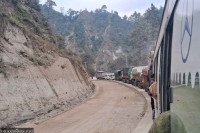Editorial
There is always an excuse
Fertiliser shortages have been a perennial problem with the authorities always finding ad-hoc measures.
The monsoon arrived early this year, and with it, the time for paddy planting, the main preoccupation of Nepal’s farmers. And, once again, the shortage of fertilisers repeats itself, like the headache facing a migraine patient. It is as if the lack of fertiliser at the peak of the paddy planting season is an inevitable force. This time, the global fertiliser crisis has come as a valid excuse for Nepali authorities who are not particularly known for looking after the plight of the farmers even if there were no global crisis. Russia’s invasion in Ukraine has worsened the crisis as the fertiliser supply chain has been disrupted, leading to an extraordinary hike in the price and a drop in the availability of fertilisers. As the Post reported on Tuesday, the country faces an acute shortage of urea, and the Rs15 billion the government has allocated for this fiscal year to purchase 500,000 tonnes of fertiliser may not be enough even to buy 200,000 tonnes.
The crisis has finally entered Nepal’s political discourse. On Monday, the fertiliser crisis became a hot topic in Parliament as 48 lawmakers deliberated on it. Lawmakers from the main opposition CPN-UML even registered an emergency motion of public importance on the crisis, and those from the ruling Nepali Congress also came on board to highlight the emergency. Even though the Agriculture Ministry claimed it was fast-tracking the import of fertilisers from India, the same has not happened yet even as the planting season is already underway. The agriculture minister has said India has assured delivery of enough fertiliser to get by this planting season, but with farmers already beginning to plant the paddy without the fertiliser, we are staring at yet another missed opportunity. Fertiliser shortages have been a perennial problem in Nepal, with the authorities always finding ad-hoc measures and giving little attention when the crisis for a particular year is over.
What is even more worrying is that the crisis is here to stay. The fertiliser crisis has led to a global crisis in the food supply chain, whose effect is already visible in Nepal, with the cost of living shooting up in an unprecedented manner. With the war in Ukraine showing no sign of stopping anytime soon, the crisis is set to worsen in the days to come. The year 2023 is going to be a tough one in terms of global food security. With Russia and Ukraine, producers of 30 percent of the world’s traded wheat and 12 percent of its calories, continuing to be embroiled in conflict, the crisis is going to exacerbate further this year. Seeing the crisis that lay ahead, India has already imposed a ban on the export of wheat. And with richer countries hoarding unjustified amounts of food to pre-empt a food crisis, poorer ones are certain to suffer.
For a country that continues to depend on imports for food security, with 4.6 million people remaining food insecure, Nepal is in dire straits. With global food prices set to increase in the months to come, Nepal should increase its food stock in advance, apart from helping farmers in their agricultural production.




 15.24°C Kathmandu
15.24°C Kathmandu














